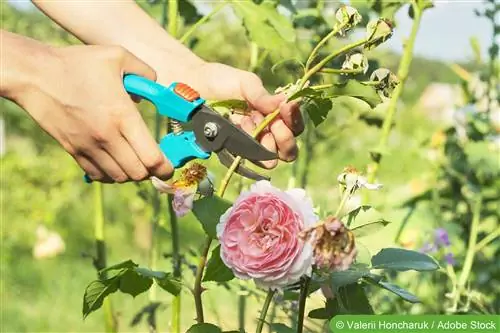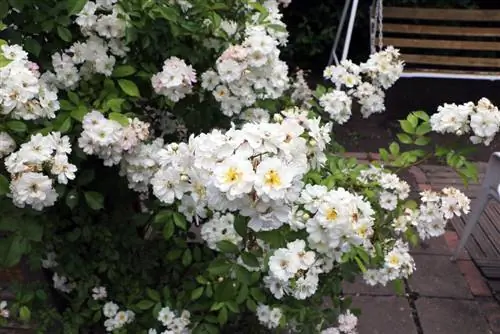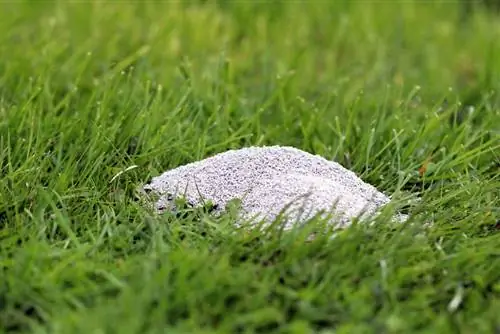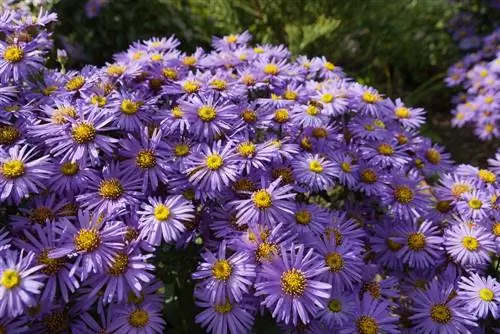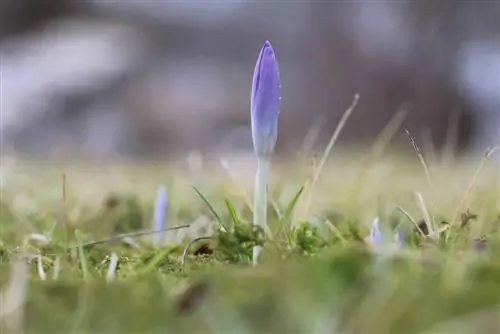- Author admin [email protected].
- Public 2023-12-17 03:39.
- Last modified 2025-06-01 06:48.
Heinrich Heine, Hermann Hesse and Johann Wolfgang Goethe have one thing in common: they created poems about the queen of all flowers. Found in every garden, no matter how small, the rose has become a cultural asset as a symbol of purity and love. If cared for properly, it will thank us in the garden with long-lasting blooms.
Suitable soil for roses
Roses are very adaptable and therefore thrive in most soils. However, fresh, fertile and permeable soil is the ideal condition. If it is also loamy and slightly sandy, then nothing stands in the way of flowering. When an old rose bed is replaced with new roses, “rose fatigue” can set in. This means the new roses will not grow well. A new place, on the other hand, gets the roses going again.
Suitable location for roses
Almost all types of roses need a sunny, wind-protected and airy location. They do not like to be placed too close to other plants or to develop in the shade of trees or bushes. If the location does not meet the needs, fungal diseases are already inevitable.
Planting time
- A rose must definitely be planted before permanent frost.
- Root growth is better and flowering can begin 2-3 weeks earlier.
Choosing the rose variety
No matter whether bare root or in a container, a rose should generally have 2-3 strong shoots. Depending on your wishes or preference, you can choose between:
- Noble roses
- Stem Roses
- Shrub roses
- Groundcover
- Climbing roses
Because there are a confusing number of options, it is advisable to visit several gardeners or providers beforehand.
Preparing to plant roses
Container roses can be planted all year round if the weather is favorable. The situation is different with bare-root roses; they must be used in their dormant phase, i.e. in autumn to early winter. The period between purchase and planting should be as short as possible. If this does not work, it is advisable to “hit” the plant somewhere. The planting distance depends on the rose variety and should be strictly adhered to.
Before planting, the rose must be watered sufficiently. The best way to do this is to bathe in water in a bucket for at least an hour. Simply place container plants in a bucket with the container. If the root ball is wrapped with any material, please carefully cut it away first. Afterwards, loose soil is removed, the roots are loosened and any damaged or dead parts are cut away with a good pair of secateurs.
Tips for planting yourself
All roots must have plenty of space in the planting hole and, if possible, not all of them point in one direction but rather be fanned out. The grafting generally needs to be several centimeters below the soil surface, except for standard roses. The finishing point is below the crown.
The plant is placed in the middle of the excavation and then buried with a mixture of garden soil, bone meal and excavated soil. Always shake gently a little so that enough soil can settle around or below the roots. As a final step, the plant is “slurried” - that is, watered with a lot of water, at least two watering cans full.
- For climbing or climbing roses, an appropriate climbing device must be installed beforehand. The rose bush is then planted at a 45 degree angle to the structure. If there is a stick against a wall, the distance should be far enough to be able to water underneath if necessary.
- Stem roses require a support to be buried. Ideally aligned with the wind direction. The support is placed first, then the rose is aligned, then both are buried.
Fertilizing roses
Roses need a lot of nutrients. Even well-prepared beds are quickly exhausted. Roses that have already been planted should be fertilized at the beginning of autumn (hardly any nitrogen, but a lot of potassium). Fertilizer should not be added fresh after planting. The first fertilizer is only incorporated in the spring after cutting.
Rose cut
Almost all newly planted roses need to be cut. This is so that strong roots can develop. The basic cut is approx. 8 cm above the ground, just above an outward-facing eye. “Old” roses are mainly freed from their “corpses” in autumn, which means that only dead, withered parts of the plant are removed. Perhaps even frostbitten buds are cut back to the fourth eye. If autumn already has many frost days, please choose milder days so that no frost damage occurs. You need the appropriate tools when pruning roses:
- sharp secateurs
- Pruning shears with a long handle
- good saw
- protective gloves
The cut must always be slanted, smooth and just above one eye. The cut also “steers” the rose in a certain direction. It is therefore usually advisable to use the outer eye. The actual cutting to stimulate growth is not carried out until spring.
How to care for roses in autumn
Fertilizing roses is important, but you should never do this in the fall. If the plants were supplied with additional fertilizer in the autumn months, the roots would literally burn. In addition, the roses would sprout again. However, new shoots are still too weak and would not survive the winter anyway. When the rose is a little more stable, you can add some manure to it and fold it in slightly. If September is very rainy, you can sprinkle some potassium magnesium around the roses. This binds a lot of water and causes the shoots to become woody.
Cut back noble roses by approx. 25 cm in the autumn months. The rose does not have to distribute the power to the shoots and so has enough energy to survive the winter and concentrate all the power in the roots. As is well known, a lot of leaves fall to the ground in the autumn months. You should definitely remove this from the rose bushes, as the damp leaves are an ideal breeding ground for germs and bacteria, which then spread to the roses in spring. It would be ideal if you removed all the leaves around the rose plant in autumn.
Rose care in autumn - the overview
Prune the roses before the first frost.
- Remove the last flowers and buds.
- Cut the canes back by 25 cm - this applies primarily to noble roses.
- For normal shrub roses, shorten the canes only slightly.
- Hedge roses do not require pruning.
- Heap the roses lightly with a little soil or cover them with brushwood or pine branches.
The actual pruning of the rose does not take place until spring.
Cold protection for roses
Unprotected, many roses die a quiet death in harsh winters. Therefore, soil and/or compost should be piled up around the root area. Another option is to combine foliage or fir and spruce branches. Standard roses must be protected with brushwood and sacks. This method is also suitable for climbing roses, as long as they are not too tall. Only use natural materials to cover, as plastic can promote premature accumulation of heat and rot.
Over the winter the rose now has time to prepare for the new year. Even if the gardener doesn't see it, this rest period is important for this plant. If care is carried out appropriately in autumn, the rose has an ideal start to a new flowering season.
Learn more about caring for roses in:
- Roses in spring
- Roses in summer
- Roses in winter

